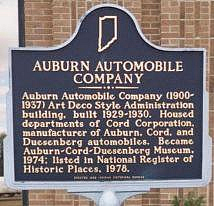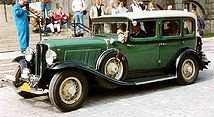
Auburn Automobile
Encyclopedia




United States
The United States of America is a federal constitutional republic comprising fifty states and a federal district...
automobile
Automobile
An automobile, autocar, motor car or car is a wheeled motor vehicle used for transporting passengers, which also carries its own engine or motor...
s produced from 1900 through 1936.
Corporate history
The Auburn Automobile Company grew out of the Eckhart Carriage Company, founded in Auburn, IndianaAuburn, Indiana
Auburn is a city in DeKalb County, Indiana, United States. The population was 13,086 at the 2010 census. Founded in 1836 by Wesley Park , the city is the county seat of DeKalb County. Auburn is also known as Home of the Classics.-Geography:...
, in 1875 by Charles Eckhart (1841–1915). Eckhart's sons, Frank and Morris, began making automobiles on an experimental basis before entering the business in earnest, absorbing two other local carmakers and moving into a larger plant in 1909. The enterprise was modestly successful until materials shortages during World War I
World War I
World War I , which was predominantly called the World War or the Great War from its occurrence until 1939, and the First World War or World War I thereafter, was a major war centred in Europe that began on 28 July 1914 and lasted until 11 November 1918...
forced the plant to close.
In 1919, the Eckhart brothers sold out to a group of Chicago investors headed by Ralph Austin Bard
Ralph Austin Bard
Ralph Austin Bard was a Chicago financier who served as Assistant Secretary of the Navy, 1941–1944, and as Under Secretary, 1944–1945. He is noted for a memorandum he wrote to Secretary of War Henry L. Stimson in 1945 urging that Japan be given a warning before the use of the atomic...
, who later served as Assistant Secretary of the Navy for President Franklin Delano Roosevelt and as Under Secretary of the Navy for President Roosevelt and for President Harry S. Truman
Harry S. Truman
Harry S. Truman was the 33rd President of the United States . As President Franklin D. Roosevelt's third vice president and the 34th Vice President of the United States , he succeeded to the presidency on April 12, 1945, when President Roosevelt died less than three months after beginning his...
. The new owners revived the business but failed to realize the profits that they hoped for. In 1924, they approached Errett Lobban Cord
Errett Lobban Cord
Errett Lobban "E. L." Cord was a leader in United States transport during the early and middle 20th century.Cord founded the Cord Corporation in 1929 as a holding company for over 150 companies he controlled, mostly in the field of transportation...
(1894–1974), a highly successful automobile salesman, with an offer to run the company. Cord countered with an offer to take over completely in what amounted to a leveraged buyout
Leveraged buyout
A leveraged buyout occurs when an investor, typically financial sponsor, acquires a controlling interest in a company's equity and where a significant percentage of the purchase price is financed through leverage...
. The Chicago group accepted. Cord aggressively marketed the company's unsold inventory and completed his buyout before the end of 1925.
But styling and engineering failed to overcome the fact that Cord's vehicles were too expensive for the Depression
Great Depression
The Great Depression was a severe worldwide economic depression in the decade preceding World War II. The timing of the Great Depression varied across nations, but in most countries it started in about 1929 and lasted until the late 1930s or early 1940s...
-era market and that Cord's stock manipulations would force him to give up control of his car companies. Under injunction from the U.S. Securities and Exchange Commission to refrain from further violations, Cord sold his shares in his automobile holding company. In 1937, production of Auburns, along with that of Cords and Duesenbergs, ended.
Models
The 1904 Auburn was a touring carTouring car
A touring car, or tourer, is an open car seating five or more. Touring cars may have two or four doors. Often, the belt line is lowered in the front doors to give the car a more sportive character. They were often fitted with a folding roof and side curtains. Engines on early models were either in...
model. Equipped with a tonneau
Tonneau
right|thumb|260px|1903 [[Ford Model A |Ford Model A]] rear-door TonneauTonneau cover , describes a hard or soft cover used to protect unoccupied passenger seats in a convertible, roadster, or for a pickup truck bed. Hard tonneau covers open by a hinging or folding mechanism while soft covers open...
, it could seat 2 or 4 passengers and sold for US$1000. The flat-mounted single-cylinder engine, situated at the center of the car, produced 10 hp (7.5 kW). A 2-speed planetary transmission was fitted. The angle-steel-framed car weighed 1500 lb (680 kg) and used half-elliptic springs
Leaf spring
Originally called laminated or carriage spring, a leaf spring is a simple form of spring, commonly used for the suspension in wheeled vehicles...
.
In 1926, Cord, now the owner of Auburn, partnered with Duesenberg
Duesenberg
Duesenberg was an Auburn, Indiana based American luxury automobile company active in various forms from 1913 to 1937, most famous for its high-quality passenger cars and record-breaking racing cars.-History:...
Corporation, famous for its racing cars, and used it as the launching platform for a line of high-priced luxury vehicles. He also put his own name on a front-wheel-drive car, the Cord
Cord Automobile
Cord was the brand name of a United States automobile, manufactured by the Auburn Automobile Company from 1929 through 1932 and again in 1936 and 1937....
, later referred to as "L-29".
Employing imaginative designers such as Alan Leamy (who was chiefly responsible for the 1933 Speedster) and Gordon Buehrig
Gordon Buehrig
Gordon Miller Buehrig was a noted automobile designer. Born in Mason City, Illinois, he had early design experience with Packard, General Motors and Stutz. In 1929, he was responsible for designing the bodies of the Stutz Black Hawks entered at Le Mans...
(who modified leftover bodies to produce the 1935 851 Speedster, and facelifted the four-door), Cord built cars that became famous for their advanced engineering as well as their striking appearance, e.g., the Model J Duesenbergs, the 1935–1937 Auburn Speedsters and the 810/812 Cords. The Auburn Boattail Speedster was a car frequently seen in Hollywood and was powered by a 4.6L straight eight that, with the popular supercharger option(150hp), could top 100mph.
The Depression
Great Depression
The Great Depression was a severe worldwide economic depression in the decade preceding World War II. The timing of the Great Depression varied across nations, but in most countries it started in about 1929 and lasted until the late 1930s or early 1940s...
, coupled with Cord's stock manipulations, spelled the end of the company. Production ceased in 1937. The company's art deco
Art Deco
Art deco , or deco, is an eclectic artistic and design style that began in Paris in the 1920s and flourished internationally throughout the 1930s, into the World War II era. The style influenced all areas of design, including architecture and interior design, industrial design, fashion and...
headquarters in Auburn now houses the Auburn Cord Duesenberg Automobile Museum
Auburn Cord Duesenberg Automobile Museum
The Auburn Cord Duesenberg Automobile Museum, also known as the Auburn Cord Duesenberg Automobile Facility, is a museum located in Auburn, Indiana that is dedicated to preserving cars built by Auburn Automobile, Cord Automobile, and Duesenberg...
. It was made a National Historic Landmark
National Historic Landmark
A National Historic Landmark is a building, site, structure, object, or district, that is officially recognized by the United States government for its historical significance...
in 2005. The Auburn Automobile Company also had a manufacturing plant in Connersville, Indiana
Connersville, Indiana
At the 2000 census, there were 15,411 people, 6,382 households and 4,135 families residing in the city. The population density was 1,894.5 per square mile . There were 6,974 housing units at an average density of 857.3 per square mile...
, that occupied a facility formerly owned by the Lexington Motor Company
Lexington Automobile
The Lexington was an automobile manufactured in Connersville, Indiana, from 1910 to 1927. From the beginning, Lexingtons, like most other Indiana-built automobiles, were assembled cars, built with components from many different suppliers...
.
See also
- List of defunct United States automobile manufacturers

